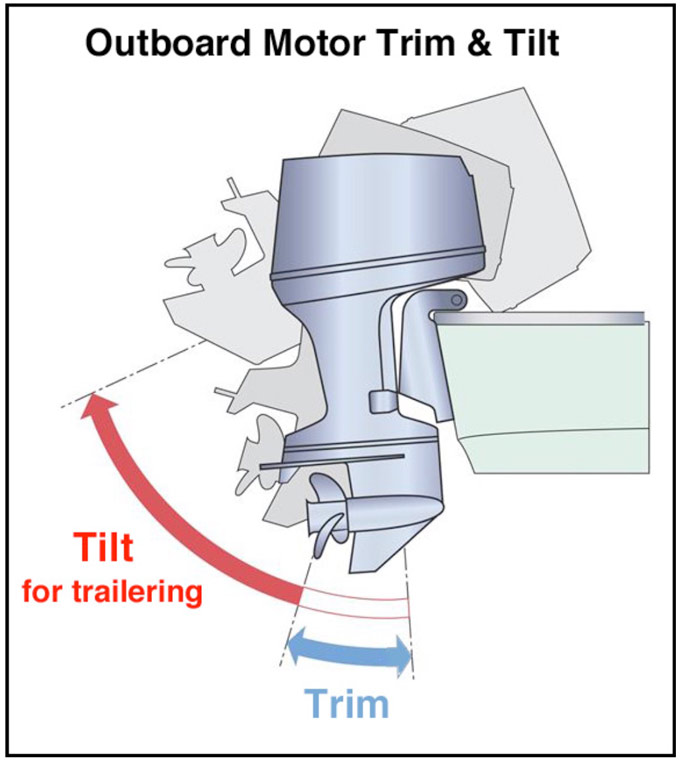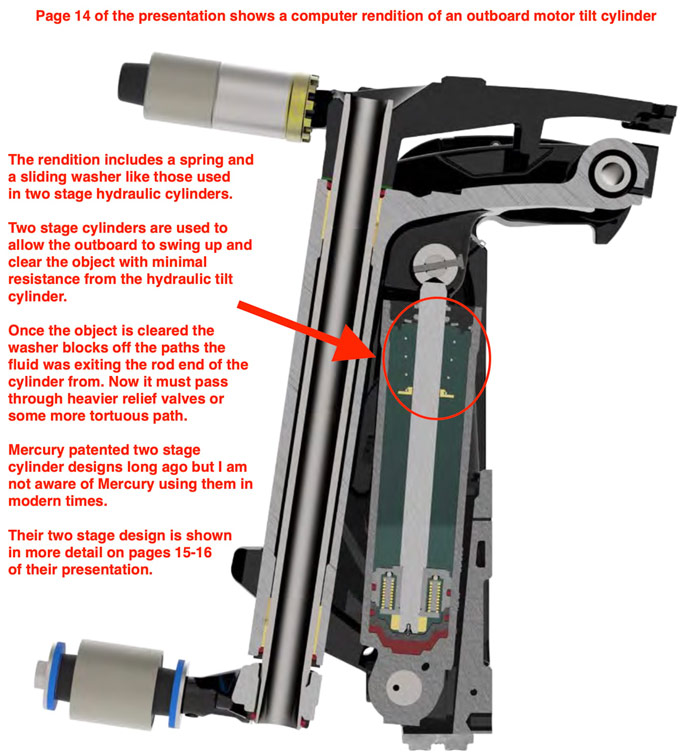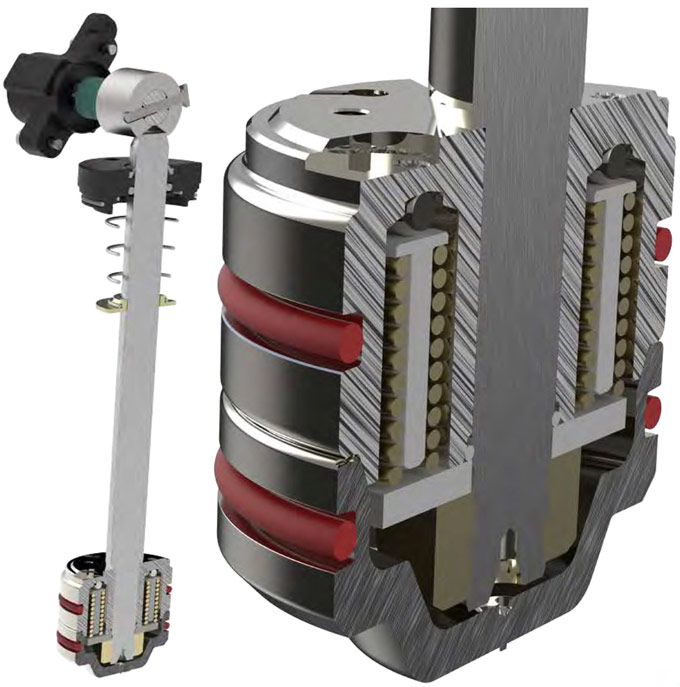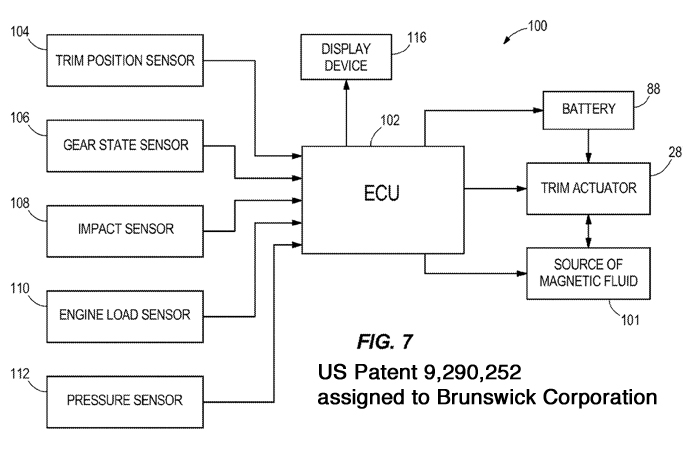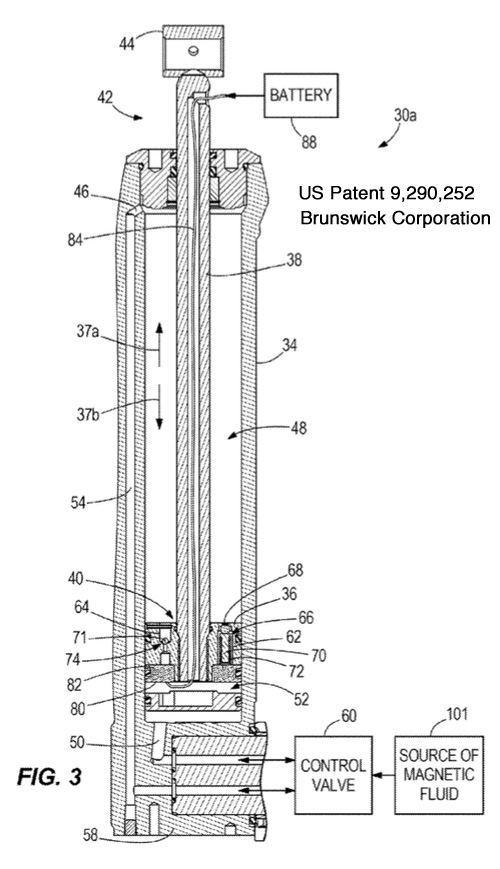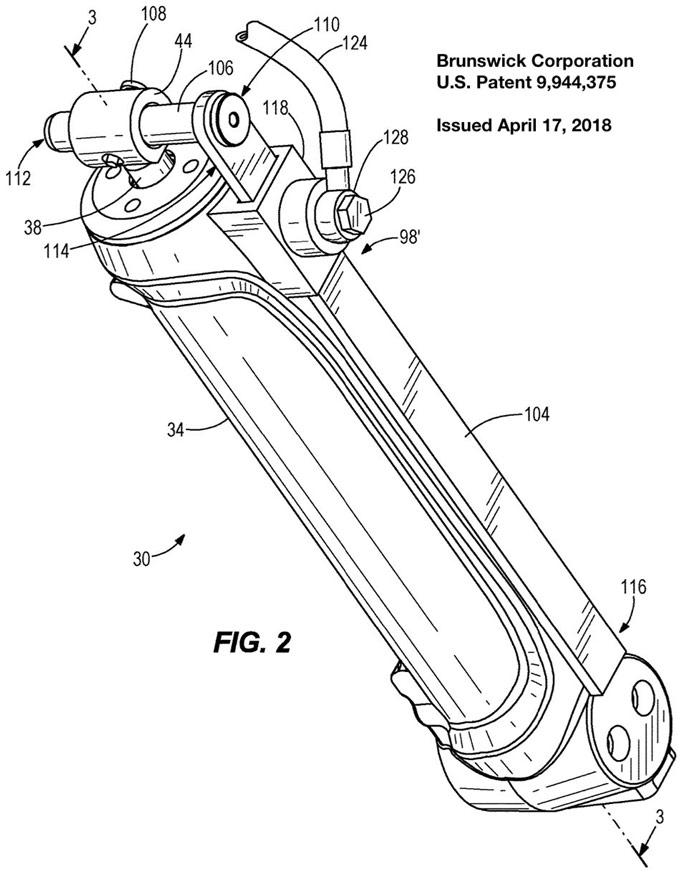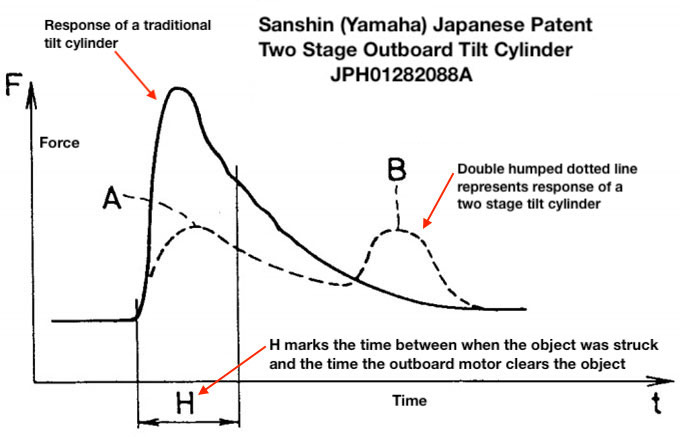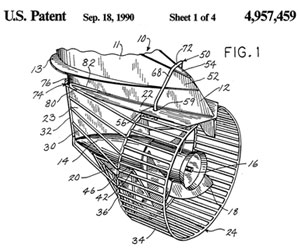Reduce Peak Impact Force of Boat Propeller Guards
This Tech Brief explains a method that may reduce maximum impact force of some boat propeller guards striking people.
This method may also:
- Reduce injuries caused by striking some boat propeller guards at lower speeds.
- Allow some propeller guards to be operated at higher speeds while causing less severe injuries to people in the water.
Propeller Safety Tech Brief #1
Note this material is NOT professional advice.
It is meant to stimulate discussion & encourage further development
of this potential approach.
Brief Description of Method
This approach uses two-stage hydraulic tilt cylinders to reduce peak impact forces between boat propeller guards and people in the water.
An example of how an outboard motor trims, then can be tilted up for trailering.
Outboard motors with hydraulic tilt and trim (many outboards of forty horsepower or more) use a hydraulic cylinder to raise and lower the outboard.
The tilt up for trailering segment is also used when an outboard motor with power tilt & trim strikes a rock. The outboard motor strikes a large log, it tilts up while its energy is dissipated by relief valves in the tilt cylinder. Use of a two stage cylinder instead of a traditional tilt cylinder allows the outboard motor to flip up and over the object with minimal resistance. Then the two stage tilt cylinder begins to cushion the upward swing of the outboard. As a result there is a significantly softer impact with the log.
Objections to Propeller Guards Based on Blunt Trauma
Page 20 of the 1989 U.S. Coast Guard National Boating Safety Advisory Council (NBSAC) propeller guard subcommittee report states, “Proponents assert that propeller guard technology and/or availability meets the foregoing criteria and that guards should be mandated. The subcommittee does not agree and offers the following comments:”
- … “Masks with wide mesh or spaced bars and ring guards may prevent cuts from body contact with a propeller but substitute the potential of blunt trauma injury, which becomes increasingly significant at speeds over 10 mph, leading to an ascending serious risk of fatality as speeds increase.”
The boating industry has long stated blunt trauma is a major reason for limiting boat propeller guards to a certain maximum speed such as 2, 5, 10, or 15 miles per hour.
1989 U.S. Coast Guard National Boating Safety Advisory Council (NBSAC) Propeller Guard Subcommittee Report
Blunt trauma issues were not proven by the 1989 NBSAC report. However, it is apparent that being struck by a propeller guard at speed is bad. Even without a propeller guard, if a person strikes the the outboard motor and somehow avoids being struck by the propeller, they can still be seriously injured or killed at speed.
Underwater Head Impact Testing at SUNY in late 1990
Outboard Marine Corporation and Mercury Marine funded an investigation into a propeller guard striking heads underwater. They used:
- A specific propeller guard invented by Dick Snyder of Mercury Marine,
- a special water facility at State University of New York at Buffalo,
- and a crash dummy to conduct the underwater tests.
Several impacts were conducted in the manner seen in the image below in late 1990.
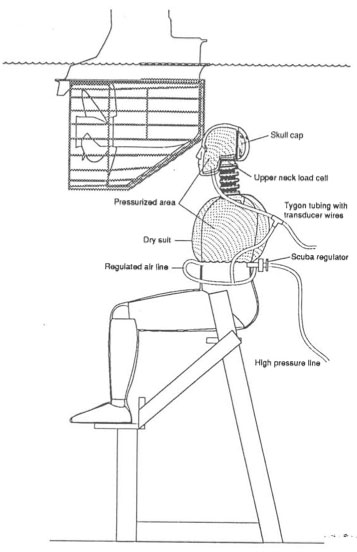
SUNY Propeller Guard Test Dummy
Conclusions of the resulting technical paper, “Injury Analysis of Impacts Between A Cage-Type Propeller Guard and a Submerged Head” coauthored by the lead researcher Michael W. Scott, include:
“The results of this study support the argument of the NBSAC report that blunt trauma injuries may become significant at speeds greater than 10 mph.”
Note the statement above is not very definitive due to the use of phrases like “support the argument” and “may become significant”.
Comparison of the 1989 NBSAC Report and the Head Impact Report Regarding Propeller Guard Top Speeds
The 1989 NBSAC report Biomechanical considerations section on pages 17 and 18 of their report stated:
“It was repeatedly stated that a skull impact of 10 mph or more in the water would generally be fatal.”
However, they cite no individuals or references as supporting the statement above.
The 1989 NBSAC report also states:
“Even with an idealized cushioning material, not currently known to exist, head or body cavity strikes at speeds over 10mph could likely be fatal.”
Again, no individual or reference is cited regarding the statement above.
In addition the use of “could likely” is very indecisive.
Need for a Solution
The NBSAC and Head Impact studies are basically saying fatalities become a major problem in propeller guard head impacts at speeds above 10 miles per hour.
Define the Problem
Mitigate propeller strike injuries due to peak impact forces, including those at speeds greater than 10 mph.
There are obviously other concerns about specific propeller guards on specific boats as speeds increase including: boat handling issues, drag, fuel consumption, and emissions.
This Tech Report only focuses on reducing peak impact forces.
The Existing Log Strike System – Typical One Stage Tilt Cylinder
Tilt cylinders have long been around to protect the outboard motor. They can prevent outboard motors from breaking off when striking obstacles such as rocks or floating logs.
Normal tilt cylinders typically have hydraulic relief valves (balls and springs) retained within the cylinder piston. The relief valves cushion the upward swing of the outboard motor when it strikes floating debris and the cylinder rod extends.
A typical single stage tilt cylinder is shown below.
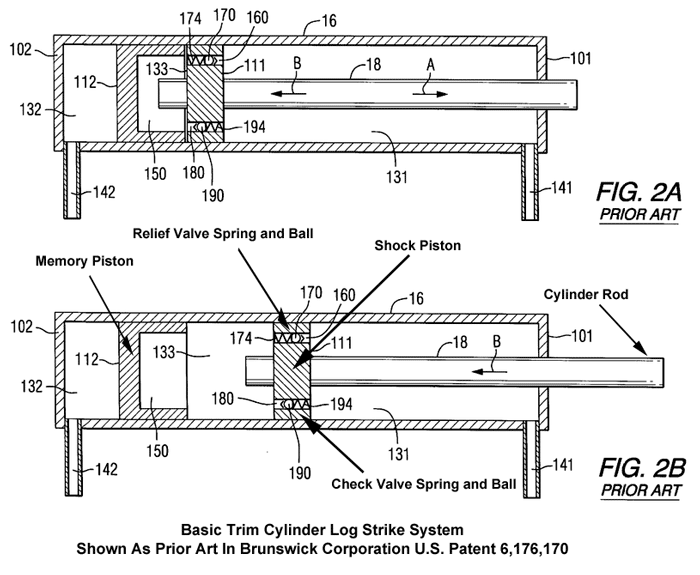
Trim Cylinder Design for Log Strike
History of Two Stage Tilt Cylinders
Sometimes one stage tilt cylinders restrict the upward swing of the outboard motor too much before it clears the object and the outboard motor breaks off.
Thus, two stage hydraulic cylinders were designed to solve this problem.
We have never seen their use on a production outboard motor, likely due to them costing a little more. Outboard motor manufacturers are very cost sensitive.
Two stage cylinders are designed to provide minimal resistance to the upward swing of the outboard motor until it clears the obstacle. Then they apply significant resistance to the upward swing of the outboard motor until it stops or reaches the top of its swing. The outboard motor then settles back down to its original trim position.
Historical Two Stage Hydraulic Tilt Cylinder Patents
Many outboard manufacturers and some third party suppliers previously developed and patented two-stage tilt cylinders for outboard motors including:
- Outboard Marine Corporation
- Yamaha/Sanshin
- Carl Kiekhaefer of Kiekhaefer Corporation which became Mercury, then Mercury Marine
- Charles Alexander of Kiekhaefer Corporation
- Volvo Penta
- Brunswick / Mercury Marine
- Parker-Hannifin
- Showa (well known Japanese manufacturer of tilt cylinders for outboard motors)
Some use a spring around the cylinder rod inside of the cylinder to time when a washer will begin to cover over some or all of the relief valve inlets. The spring method sometimes simultaneously creates a more tortuous path through some of the relief valves that increases the relief valve pressure as the cylinder rod extends. Another feature is some of the relief valves can have a higher pressure setting than others. The relief valves with a lower setting can be covered up by the washer only leaving the relief valves with the higher setting open to flow after the outboard clears the object.
References
- “Approaches to Prevent Outboard Motors From Flipping Into Boats After Striking Floating or Submerged Objects. 2018. Pages 28-38.
- “Approaches to Prevent Outboard Motors From Flipping Into Boats After Striking Floating or Submerged Objects. Supplement #1. 2020. Pages 5-7.
Mercury Marine Modern Two-Stage Hydraulic Tilt Cylinders
Mercury Marine showed a two-stage hydraulic tilt cylinder design in a 2017 presentation to the Western Dredge Association. Clips from pages 14 and 15 of that presentation are shown below.
Recent Brunswick Patent for Digitally Controlled Two-Stage Hydraulic Tilt Cylinder
Brunswick patented a two stage cylinder using magnetic fluid that allows it to dynamically respond to log strikes (and human strikes). An electric charge adjusts the viscosity of the tilt cylinder fluid exiting the rod end of the tilt cylinder allowing the fluid itself to act as a virtual relief valve. The system can act as a two stage hydraulic tilt cylinder by reducing the pressure in the rod end of the cylinder as the fluid escapes until it clears the object.
The magnetic fluid system then shifts to a higher virtual relief valve setting until the upward swing of the drive is halted. This system can be controlled by the Engine Control Unit (ECU) allowing it to make decisions based upon multiple variables. See the images below:
Below is a chart showing some of the variables Brunswick’s magnetic tilt cylinder can take into account as it maps out the best way to handle a specific impact.
Another Recent Brunswick Patent for a Digitally Controlled Two Stage Cylinder
Brunswick also recently patented a digitally controlled hydraulic tilt cylinder using normal hydraulic fluid. It includes feeding back the amount of extension of the cylinder rod (its position) which can also be used to dynamically calculate the position of the cylinder piston. This design also includes a hydraulic brake that can be used to prevent the cylinder rod from extending when the drive is operating in reverse. It also provides additional resistance to the upward swing of the outboard motor after it clears the object. See the image below.
This position sensing version of a hydraulic tilt cylinder also has an operational chart fairly similar to the chart for the two stage tilt cylinder using magnetic fluid.
Normal tilt cylinders must have their internal relief valve set high enough to prevent the drive from trimming out in reverse.
Digital tilt cylinders have many options to prevent the tilt cylinder from trimming out in reverse.
Sanshin / Yamaha Two Stage Cylinder Patent Drawing Shows Lowering of Peak Impact Force
A Japanese Sanshin / Yamaha patent for a two stage tilt cylinder provided the force vs. time graph below.
The graph above shows the peak impact force for a traditional outboard tilt cylinder is much greater (the solid line) than that of a two stage tilt cylinder (the dotted two humped curve).
The two stage cylinder quickly lets fluid out of the rod end of the cylinder when an object is struck, then begins to resist the upward swing of the outboard as soon as the object is cleared by the outboard.
The Solution to Reducing Propeller Guard Impact Forces
Use two stage cylinders in combination with propeller guards to reduce peak forces and accelerations to humans struck in the water while underway.
Humans may be lighter than logs, but they can still activate the log strike system when they are struck, especially when struck by smaller outboards at modest speeds.
Two stage cylinders provide minimum resistance to the outboard swinging upward until the outboard clears the human.
The new digital two stage tilt cylinders for outboard motors offer on most countless ways of making this system even better. For example you know when the system is underway in reverse. The system could run with an extremely low relief valve setting when they vessel is not underway in reverse. Larger outboards would need a higher relief valve setting to cover running in rough water or being airborne and re-entering the water.
What Type of Propeller Guards Might Benefit the Most From The Use of Two Stroke Cylinders
Some propeller guards wrap around the front on the lower leading edge of the outboard motor. Examples include:- Cage type guards that actually wrap around the lower leading edge of the drive, such as Dick Snyder / Mercury Marine’s propeller guard as shown at right.
- Vane type propeller guards like those built by MidCoast Marine.
- More conventional looking cage type propeller guards like those built by Propeller Guard Technologies. Their drives are tied to the outboard motor. The outboard motor and the propeller guard are basically one piece.
Mike Scott’s data from the SUNY head impact studies can be seen in an earlier volume of his report. The data shows the drive partially swinging up via an accelerometer placed at the rear of the torpedo at higher impact speeds. The same effect can be seen with lower peak accelerations for off center strikes. Minimal upward swing is visible in the videos accompanying the SUNY head impact tests.
Scott’s testing results were more severe than would actually occur in the field for multiple reasons. Among them was they trimmed the outboard motor down against a trim limit peg and built up the rod end pressure to the relief drive pressure before every test run. They said they did it to represent propeller force. By pre-charging the rod end of the cylinder to the relief valve pressure there was no longer a brief cushion while that pressure built up when a person was struck. This increased the acceleration of the head when it was struck.
Additional Benefits
- The use of two stage tilt cylinders can reduce damage to propeller guards when grounding or striking rocks while underway.
- The use of two stage tilt cylinders can help prevent outboard motors from breaking off and flipping into boats at higher speeds.
- Improve the life of marine drives by reducing peak impact forces.
- The use of digitally controlled two stroke cylinders (like the two Brunswick digitally controlled hydraulic tilt cylinders shown earlier) brings almost endless possibilities and features, including running with the equivalent of pressure relief valves set at near zero.
Testing
This Tech Brief is very general.
It will take considerable effort to test this approach.
That testing might be significantly sped up if researchers had access to a dry land impact test stand like the one at Mercury Marine.
The method will likely prove to be most effective on smaller outboard motors.
Wrapping Things Up
We considered calling the use of two stroke cylinders to reduce peak force when a person is struck by a propeller guard an invention.
We did not because the boating industry developed this approach over 50 years ago to prevent the outboard motor from breaking off when it struck a log or rock.
To our knowledge, two stage hydraulic tilt cylinders never made it to production, but almost everybody developed one at one time of another.
Recent developments in this field by Brunswick may finally bring them into production.
April 28, 2023 Update
Rental Pontoons Boats, Rental Houseboats, & SOLAS Tender Applications
Two-stage tilt cylinders may prove to be especially adaptable to rental pontoon boats and rental houseboats with top speeds faster than those currently considered for adapting cage type propeller guards. Two-stage tilt cylinders not only have the capability of reducing peak impact forces to people in the water, but also provide protection to the propeller guard and outboard motor when striking rocks or hitting bottom while beaching.
Two-stage tilt cylinders may also be applicable to outboard motors powering SOLAS (Safety Of Life At Sea) tenders. These Rigid Inflatable Boats (RIBS) on larger yachts are used to transport people, supplies, and trash to and from shore while doubling as a rescue boat. SOLAS standards require them to have a propeller guard. SOLAS tenders range from smaller outboards up to about 150 horsepower and typically go faster than displacement pontoons or houseboats. SOLAS certification of outboard motors covers several items including requiring a propeller guard. Mercury Marine and Yamaha are among the manufacturers producing SOLAS certified outboard motors.
Comments
We welcome your comments
